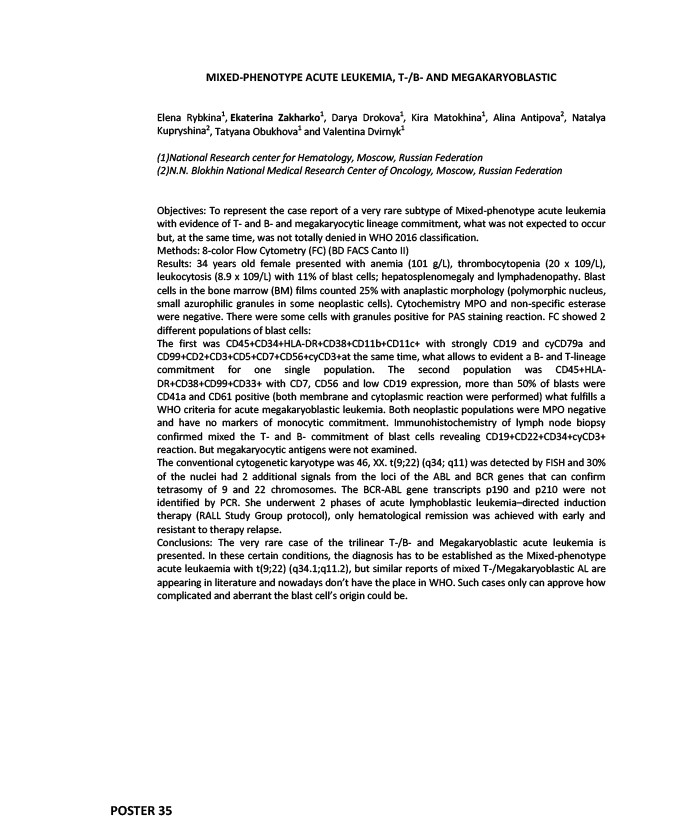
POSTER 35
MIXED-PHENOTYPE ACUTE LEUKEMIA, T-/B- AND MEGAKARYOBLASTIC
Elena Rybkina1, Ekaterina Zakharko1, Darya Drokova1, Kira Matokhina1, Alina Antipova2, Natalya
Kupryshina2, Tatyana Obukhova1 and Valentina Dvirnyk1
(1)National Research center for Hematology, Moscow, Russian Federation
(2)N.N. Blokhin National Medical Research Center of Oncology, Moscow, Russian Federation
Objectives: To represent the case report of a very rare subtype of Mixed-phenotype acute leukemia
with evidence of T- and B- and megakaryocytic lineage commitment, what was not expected to occur
but, at the same time, was not totally denied in WHO 2016 classification.
Methods: 8-color Flow Cytometry (FC) (BD FACS Canto II)
Results: 34 years old female presented with anemia (101 g/L), thrombocytopenia (20 x 109/L),
leukocytosis (8.9 x 109/L) with 11% of blast cells; hepatosplenomegaly and lymphadenopathy. Blast
cells in the bone marrow (BM) films counted 25% with anaplastic morphology (polymorphic nucleus,
small azurophilic granules in some neoplastic cells). Cytochemistry MPO and non-specific esterase
were negative. There were some cells with granules positive for PAS staining reaction. FC showed 2
different populations of blast cells:
The first was CD45+CD34+HLA-DR+CD38+CD11b+CD11c+ with strongly CD19 and cyCD79a and
CD99+CD2+CD3+CD5+CD7+CD56+cyCD3+at the same time, what allows to evident a B- and T-lineage
commitment for one single population. The second population was CD45+HLA-DR+
CD38+CD99+CD33+ with CD7, CD56 and low CD19 expression, more than 50% of blasts were
CD41a and CD61 positive (both membrane and cytoplasmic reaction were performed) what fulfills a
WHO criteria for acute megakaryoblastic leukemia. Both neoplastic populations were MPO negative
and have no markers of monocytic commitment. Immunohistochemistry of lymph node biopsy
confirmed mixed the T- and B- commitment of blast cells revealing CD19+CD22+CD34+cyCD3+
reaction. But megakaryocytic antigens were not examined.
The conventional cytogenetic karyotype was 46, XX. t(9;22) (q34; q11) was detected by FISH and 30%
of the nuclei had 2 additional signals from the loci of the ABL and BCR genes that can confirm
tetrasomy of 9 and 22 chromosomes. The BCR-ABL gene transcripts p190 and p210 were not
identified by PCR. She underwent 2 phases of acute lymphoblastic leukemia–directed induction
therapy (RALL Study Group protocol), only hematological remission was achieved with early and
resistant to therapy relapse.
Conclusions: The very rare case of the trilinear T-/B- and Megakaryoblastic acute leukemia is
presented. In these certain conditions, the diagnosis has to be established as the Mixed-phenotype
acute leukaemia with t(9;22) (q34.1;q11.2), but similar reports of mixed T-/Megakaryoblastic AL are
appearing in literature and nowadays don’t have the place in WHO. Such cases only can approve how
complicated and aberrant the blast cell’s origin could be.